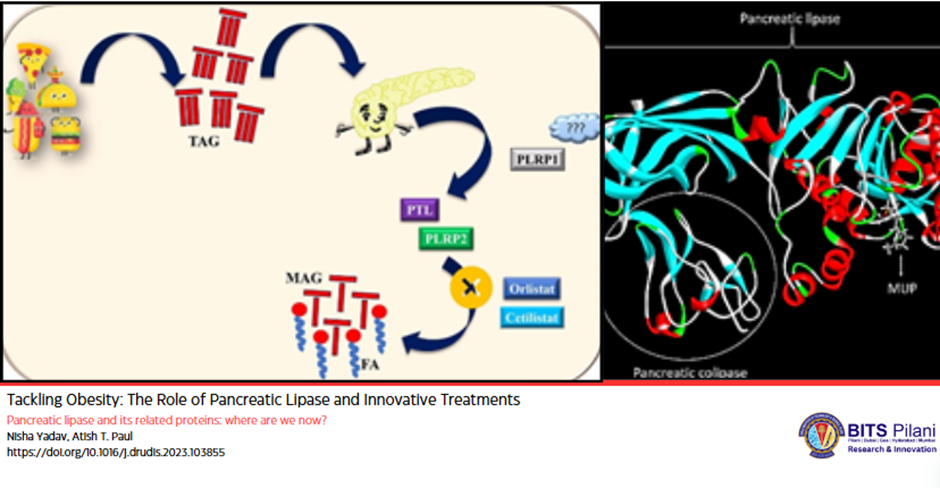Obesity stands as a pressing global health issue, prompting intensive research into effective interventions and their broader impacts on health. Prof. Atish T. Paul and his Natural Product Research Group (NPRG) at the Department of Pharmacy, BITS Pilani (Pilani campus) are actively investigating diverse strategies for weight loss that includes design and synthesis of novel preclinical candidates, exploring synergy concept for combination development and examining untapped microbial sources.
Pancreatic lipase (PTL) is an enzyme that hydrolyse 50-70% triacylglycerol (TAG) from food has been identified as an important target for the prevention and treatment of obesity. Currently, Orlistat is the only clinically prescribed long term anti-obesity drug which prevents the digestion and absorption of fat by inhibiting PTL.
Key Insights
- Pancreatic lipase (PTL) is an important target for development of effective pharmacological treatments for obesity
- The sole two approved medications are Orlistat and Cetilistat
- Clinical trials are being conducted to evaluate the efficacy of Orlistat in combination with other drugs for weight loss
- Weight loss medication in combination with weight management programs can lead to greater weight loss
- Different macronutrients can affect the secretion of gastrointestinal hormones in patients who have undergone gastric bypass surgery
The worldwide overweight and obesity epidemic has been referred to as a "silent public health crisis" due to the fact that it is widespread across the entire world and has not received a large amount of attention from researchers. According to the findings of a study conducted by the World Obesity Federation, it is anticipated that by the year 2030, the number of people who are categorized as obese would surpass one billion, with approximately 250 million of those individuals being children and adolescents.
The term "obesity" indicates an anomalous increase in body fat that results from a persistent discrepancy between the amount of energy utilized and the amount of food consumed over a period of time. Some of the chronic metabolic disorders that are associated with obesity include type 2 diabetes mellitus, dyslipidemia, and non-alcoholic fatty liver disease. A variety of pharmaceutical medications, surgical procedures, and behavioural health programs that prioritize lifestyle modifications can be employed to prevent and treat obesity. Nevertheless, the effects of this approach may not be immediately apparent. It is important to possess an in-depth grasp of pharmacological therapies, as they continue to be a major therapeutic option.
There have been a number of therapeutic targets for obesity that have been investigated over the years. PTL has been identified as a key target for the prevention and treatment of obesity-related disorders. In the proximal small intestine, this enzyme is responsible for the hydrolysis of 50-70% of the total lipids that are consumed through food. Therefore, the absorption of fat can be reduced by utilizing PTL inhibitors, which leads to weight loss (Figure 1).
The mechanisms that are involved in fat absorption, digestion, and reabsorption have been investigated, especially the role of PTL, PLRP1 and PLRP2 is investigated. These mechanisms have the potential to be targeted for the development of future anti-obesity drugs. Currently, a number of innovative products that contain Orlistat, either alone or in combination, are undergoing various phases of clinical trials and have the potential to become future anti-obesity therapy. The PTL-targeted antiobesity drug discovery process is currently impeded by a lack of comprehensive understanding of the affinity of PLRP1 for colipase, the low production of PLRP 1 and 2 by pancreatic acinar cells in comparison to PTL, the developmental stage at which PTL initiates fat digestion, and the global approval status of Cetilistat despite the results of Phase III clinical trials. Furthermore, despite extensive research on natural products and their inspired analogues for PTL inhibition, no new medications have been licensed or even entered clinical trials. In summary, the current scarcity of viable options in this field necessitates the development of novel, safe compounds for the pharmacological treatment of obesity. The obesity free future of coming generations lies in answering the above questions.


 An Institute of Eminence
An Institute of Eminence








